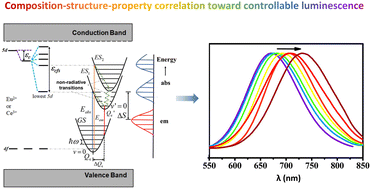J. Mater. Chem. C, 2023,11, 48-96, https://doi.org/10.1039/D2TC02639B

Ce3+/Eu2+ activated luminescent materials offer a versatile platform for precise emission light manipulation through structure control on the basis of the composition–structure–property correlations. To date, Ce3+/Eu2+ activated phosphors have been well developed as an indispensable component in the lighting industry and display systems due to their superior performance. Meanwhile, many persistent phosphors contain Ce3+/Eu2+ together with other lanthanide or transition-metal co-dopants. It is therefore of great importance to focus on their similarities and gain insight into the interplay effect of the local structure and electronic structure on emission peak modulation and persistent duration elongation. Here, we review the theoretical and experimental progress in the discovery and optimization of Ce3+/Eu2+ activated LEDs and persistent phosphors. The Dorenbos model on f–d transitions and the latest developments in the correlation of the local structure and luminescence characteristics are elaborated to give an overall vision on the composition–structure–property correlations in Ce3+/Eu2+-activated phosphors. Particular attention is devoted to highlighting the critical role of the electronic structure in tuning the properties of phosphors. The development and optimization routines of some typical phosphors are expounded, with an emphasis on phosphor design principles, aiming at providing inspirations for tailoring and optimizing the properties of Ce3+/Eu2+-activated phosphors toward specific applications. Finally, we propose an outlook toward potential theory developments and future material discovery.

